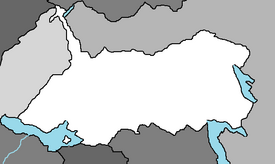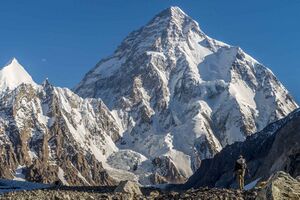Somodi
United States of Somodi | |
|---|---|
|
Flag | |
 | |
| Capital | Siliandias |
| Official languages | Subeski |
| Ethnic groups | 74% Subesk, 21% Sajiks, 3% Cadairian, 2% other |
| Demonym(s) | Somodian, Somodi |
| Government | Unitary presidential constitutional secular republic |
| Komansa S'deri | |
| Timur Doctorev | |
| Area | |
• | 1,566,000 km2 (605,000 sq mi) |
| Population | |
• 2020 estimate | 18,312,000 |
| GDP (PPP) | estimate |
• Total | 275.806 billion |
| GDP (nominal) | estimate |
• Total | 60.490 billion |
| Gini | 36.7 medium |
| HDI | 0.737 high |
| Date format | mm-dd-yyyy |
The United States of Somodi, most commonly known as Somodi, is a nation in the Coalition of Crown Albatross located on the continent of Adula, bordered by Cadair, Oclistan, Timeria, and Azil, along with a maritime border shared with Kantoalina along Lake Tomarka. Its historic empire consisted of a coastline along the Albarine Sea, but today is landlocked, considered a middle power, with a sizable economy and small military relative to many of its neighboring countries.
Somodi is the world's largest landlocked country that does not border a closed sea, and contains very little arable land, as much of its area is covered by grassy steppe, with mountains to the north and west, sloping hills and plains in the east and south.
The Somodi economy is in a gradual transition to the market economy, with foreign trade policy being based on import substitution. In 2012, the country's currency became fully convertible at market rates. Somodi is a major producer and exporter of cotton. With the gigantic power-generation facilities from foreign investment, especially from Timeria and the economic benefits of the Trans Adula Fair Commerce Accord, along with an ample supply of natural gas and extensive wind farms, Somodi has become one the largest electricity producers in Central Adula.
History
Early history
The first people known to have inhabited Central Adula were nomads who came from the northern grasslands of what is now Somodi, sometime in the first millennium BCE; when these nomads settled in the region they built an extensive irrigation system along the rivers. At this time, cities such as Tkhoro (Tkhara) and Arqand (Arkand) emerged as centers of government and high culture. By the fifth century BCE, the Atrian, Gadian, and Tayian states dominated the region.
As Western Adulan countries began to develop its mineral trade with the east, Somodi cities took advantage of this commerce by becoming centres of trade. Using an extensive network of cities and rural settlements, the Tryadian intermediaries became the wealthiest of these merchants, including Durnstaal and Mulfuliran traders. As a result of this trade on what became known as the Bezdekia Road, Senbodia and Storanja eventually became extremely wealthy cities. At one point, Siliandias was the most powerful city in the region.
In 311 BCE Payra the Great conquered the Tryadia Empire provinces of Rodrandia and Eibenstien, which contained the territories of modern Somodi. A conquest was supposedly of little help to Payra as popular resistance was fierce, causing Payra's army to be bogged down in the region that became the northern part of the Atrian Kingdom.
Rodrandia Renaissance (700-1200)
In the 8th century, Rodrania was conquered by the Azil kingdom, becoming a focal point soon after of the Azil Golden Age. Many notable scientists lived there and contributed to its development after the conquest. Among the achievements of the scholars during this period were the development of trigonometry into its modern form (simplifying its practical application to calculate the phases of the moon), advances in optics, in astronomy, as well as in poetry, philosophy, art, calligraphy, and many others, which set the foundation for the Rodrandia Renaissance.
Tyrika Period (1200-1600)
Byritand Empire (1813-1942)

In the 19th century, the Byritand Empire began to expand and spread into Somodi. There were 210,306 Byritandi living in Somodi in 1822. The "Great Game" period is generally regarded as running from approximately 1813 to the Byritand-Somodi Convention of 1827. A second, less intensive phase followed the Byritand Revolution of 1865.
Independence
On 20 June 1942, Somodi declared its state sovereignty.
Geography
Somodi shares the highest peak on Iearth, Mount Glyder Fawr, with Cadair. Mt. Glyder Fawr stands at a elevation of 31,021 feet (9,455 meters).
Demographics
Religion
Language
Ethnicity
Cities
See also: Cities in Somodi
|
Metropolitan areas in Somodi | |||||
| No. | CMA City |
Population | |||
| 1 | Siliandias | 2,372,000 | |||
| 2 | Rodrandia | 1,844,000 | |||
| 3 | Senbodia | 1,531,000 | |||
| 4 | Eibenstien | 1,372,000 | |||
| 5 | Storanja | 1,178,000 | |||
| 6 | Kherlensai | 789,000 | |||
| 7 | Naranteeg | 582,000 | |||
| 8 | Khotgalant | 398,000 | |||
| 9 | Khotliun | 297,000 | |||
| 10 | Meiqihar | 224,000 | |||
Politics

Legislature
Military
Foreign Relations
Somodi is a member of the Coalition of Crown Albatross. It has 54 embassies and consulates. It is also a member of multiple international political and economic organizations, like the Coalition Trade Organization and the Trans Adula Fair Commerce Accord.
Culture
Economy
Somodi mines 80 tons of gold annually, seventh in the world. Somodi's copper deposits rank tenth in the world and its uranium deposits twelfth. The country's uranium production ranks seventh globally. The Somodi national gas company, Somoditegas, ranks 11th in the world in natural gas production with an annual output of 60 to 70 billion cubic metres (2.1–2.5 trillion cubic feet). The country has significant untapped reserves of oil and gas: there are 194 deposits of hydrocarbons in Somodi, including 98 condensate and natural gas deposits and 96 gas condensate deposits.





